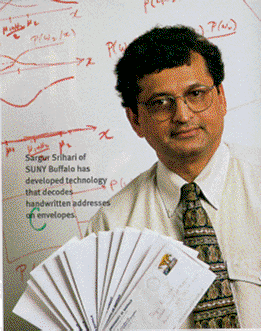


TAMPA OR TEMPE? BROADWAY OR BROAD Street? Gone may be the days when bleary- eyed post office clerks laboriously squinted at indecipherable addresses scrawled on envelopes.
Sargur Srihari, executive director of the Center of Excellence for Document Analysis and Recognition (CEDAR) at the State University of New York at Buffalo, is trying to make things a little easier for Postal Service workers. Srihari has developed technology that decodes envelopes addressed in longhand.
He and his associates designed Handwritten Address Interpretation (HWAI) technology to examine whole words in addresses rather than examine words one letter at a time, as is typical of many handwriting recognition systems (personal digital assistants, for example). HWAI also cheats a bit: The system's secret of success is that it looks at the envelope's ZIP code and accesses a database of possible street names within that area, then compares that information to the beginning of the handwritten street address.
Cheating or not, the system is paying off: A test deployment in Tampa, Fla., that began in December 1996 worked well enough that HWAI systems are now in place at all 255 of the USPS's major processing and distribution centers, according to Srihari. The HWAI systems successfully recognize the ZIP code for roughly 70 percent of handwritten addresses and achieve full address recognition for 30 percent. The systems may cut post office labor costs by as much as $150 million per year by reducing the need for human intervention in routing hand-addressed letters.
At that rate, one year's savings will easily justify the USPS's investment in Srihari's research--the Postal Service has been funding his work since he first approached the agency with the idea in 1983. Srihari also notes that the agency had a billion-dollar budget surplus in 1997. "We like to think that about one-tenth of that billion-dollar surplus was our contribution," Srihar says.
--Derek Slater